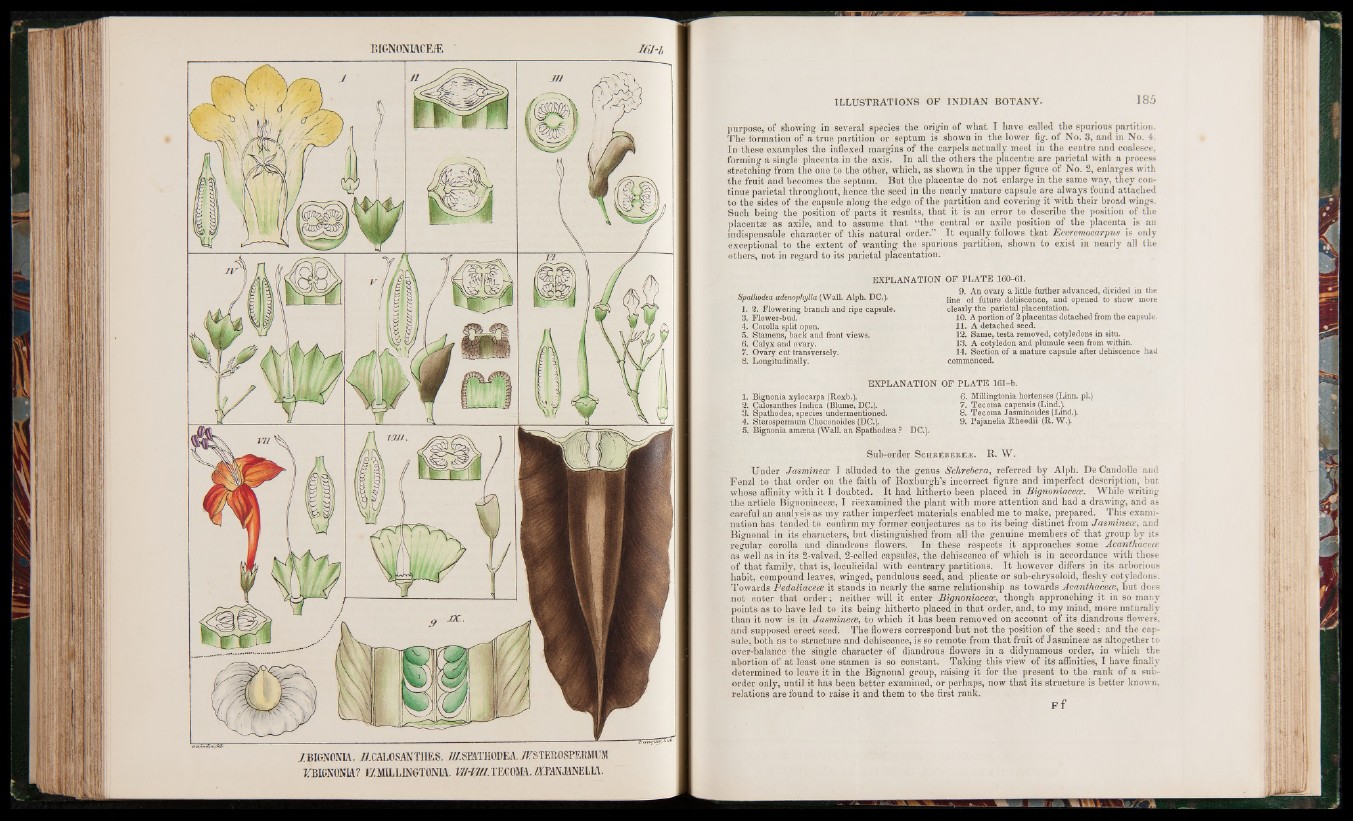
BIGNONIACEÆ
/BIGNONIA. 77.CAL0SANTHES. ///.SPATHODEA. 7TSTER0SPERMUM
BBIONONIA? 17 MILL INGTONIA. W V I I I . TECOMA.7XPANA4NELIA.
purpose, of showing in several species the origin of what I have called the spurious partition.
The formation of a true partition or septum is shown in the lower fig. of No. 3, and in No. 4.
In these examples the indexed margins of the carpels actually meet in the centre and coalesce,
forming a single placenta in the axis. In all the others the placentae are parietal with a process
stretching from the one to the other, which, as shown in the upper figure of No. 2, enlarges with
the fruit and becomes the septum. But the placentae do not enlarge in the same way, they continue
parietal throughout, hence the seed in the nearly mature capsule are always found attached
to the sides of the capsule along the edge of.the partition and covering it with their broad wings.
Such being the position of parts it results, that it is an error to describe the position of the
placentae as axile, and to assume that “the central or axile position of the placenta is an
indispensable character of this natural order.” I t equally follows that Eccremocarpus is only
exceptional to the extent of wanting the spurious partition, shown to exist in nearly all the
others, not in regard to its parietal placentation.
EXPLANATION
Spathodea adenophylla (Wall. Alph. DC.)*
1. 2. Flowering branch and ripe capsule.
3. Flower-bud.
4. Corolla split open.
5. Stamens, back and front views.
6. Calyx and ovary.
7. Ovary cut transversely.
8. Longitudinally.
EXPLANATION
1. Bignonia xylocarpa (Roxb.).
2. Calosanthes Indica (Blume, DC.).
3. Spathodea, species undermentioned.
4. Sterospermum Checonoides (DC.).
5. Bignonia amasna (Wall, an Spathodsea ? DC.).
OF PLATE 160-61.
9. An ovary a little further advanced, divided in the
line of future dehiscence, and opened to show more
clearly the parietal placentation.
10. A portion of 2 placentas detached from the capsule.
11. A detached seed.
12. Same, testa removed, cotyledons in situ.
13. A cotyledon and plumule seen from within.
14. Section of a mature capsule after dehiscence had
commenced.
OF PLATE 161-b.
6. Millingtonia hortenses (Linn, pi.)
7. Tecoma capensis (Lind.).
8. Tecoma Jasminoides (Lind.).
- 9. Pajanelia Rheedii (R. W.).
Sub-order Schrebere/e. R. W.
Under Jasminece T alluded to the genus Schrebera, referred by Alph. De Candolle and
Fenzl to that order on the faith of Roxburgh’s incorrect figure and imperfect description, but
whose affinity with it I doubted. It had hitherto been placed in Bignoniacece. While writing
the article Bignoniaceae, I reexamined the plant with more attention and had a drawing, and as
careful an analysis as my rather imperfect materials enabled me to make, prepared. This examination
has tended to confirm my former conjectures as to its being distinct from Jasminecer and
Bignonal in its characters, but distinguished from all the genuine members of that group by its
regular corolla and diandrous flowers. In these respects it approaches some Acanthacece
as well as in its 2-valved, 2-celled capsules, the dehiscence of which is in accordance with those
of that family, that is, loculicidal with contrary partitions. I t however differs in its arborious
habit, compound leaves, winged, pendulous seed, and plicate or sub-chrysoloid, fleshy cotyledons.
Towards Pedaliacece it stands in nearly the same relationship as towards Acanthacece, but does
not enter that order; neither will it enter Bignoniacece, though approaching it in so many
points as to have led to its being hitherto placed in that order, and, to my mind, more naturally
than it now is in Jasminece, to which it has been removed on account of its diandrous flowers,
and supposed erect seed. The flowers correspond but not the position of the seed; and the capsule,
both as to structure and dehiscence, is so remote from that fruit of Jasminese as altogether to
over-balance the single character of diandrous flowers in a didynamous order, in which the
abortion of at least one stamen is so constant. Taking this view of its affinities, I have finally
determined to leave it in the Bignonal group, raising it for the present to the rank of a suborder
only, until it has been better examined, or perhaps, now that its structure is better known,
relations are found to raise it and them to the first rank.
F f